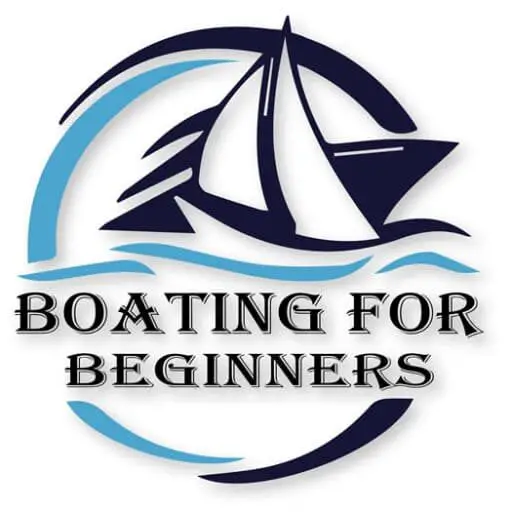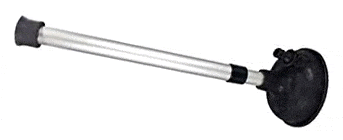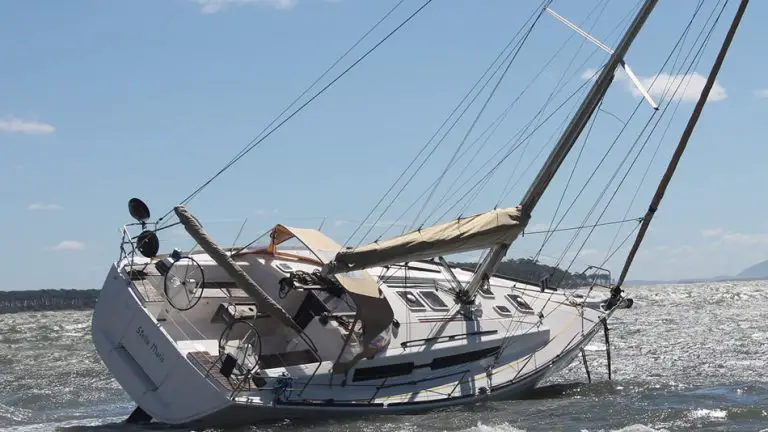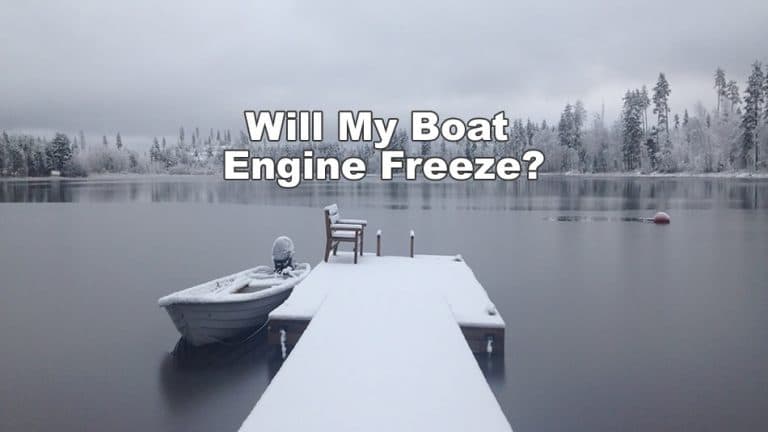Starting Boat Motor Out Of Water
I’ve heard a lot of boaters talking about how they start their inboard or outboard engine while the boat is on land so they can test the motor before they have it on the boat launch. That got me wondering how safe it could be for the engine, so I did some research.
As it turns out, you can safely start your boat engine while out of the water as long as you have a properly connected water supply, like a garden hose attached to the water intake vent. You can use specially designed products that are available that will fit an outboard or inboard water intake to act as if the boat was sitting in water.
Below I’ll go over the different ways that you can safely start your boat engine without even being near a body of water.
How To Start an Outboard Boat Engine Out Of Water
Starting an outboard boat engine out of the water can be done by using a tool called a Moeller Flushrite Boat Motor Flusher. This tool is designed to look like ear muffs so that it can firmly attach itself to the inlet vents on the motor. The inlet vent is what sucks the water in to cool off the engine while it is running.
While connected to a water supply such as a garden hose, the motor flusher will allow you to provide enough water so that you can start the engine on land without worrying about overheating. However, with that said, you should still keep an eye on the temperature gauge while the engine is running and turn it off if the temperate reaches 200 Fahrenheit.
A lot of outboards come with flushing attachments already built into the motor; however, these should not be used to run your engine on land. What these built-in attachments are for is simply just rinsing your motor out, and they do nothing for cooling the engine.
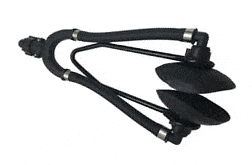
When it comes to buying a motor flusher, there are different sizes and styles that you can choose from. I would recommend going with a dual flow setup for maximum water coverage as well as the rectangular cups. The rectangular cups fit better and cover more of the inlet vents. You can buy them online from Amazon for about $30. Click here for the current price.
How to set up the Moeller Flushrite Boat Motor Flusher
- Attach a garden hose to the motor flusher. Ensure that the garden hose is tight and secure.
- Turn on the garden hose all the way to confirm that there is a solid flow of water, then turn it off for now.
- Set the outboard engine to an upright position.
- Locate the water inlet vents on the outboard motor. These are located in the gear case down near the bottom, above the propeller shaft area.
- Attach the motor flusher from the back of the engine and position the rectangular cups overtop of the water inlet vents. Ensure that all holes are covered so that you don’t have any water leakage or induce air into your water flow system.
- Turn the water on all the way. You should notice that water is flowing down from the motor flusher, this is completely normal.
- Now that the water supply is hooked up, you can safely start your outboard engine. Once the engine starts, you’ll also notice that the water that was flowing down has started to flow much slower. You should also see water squirting out of the outlet now.
- While the engine is running, keep a close eye on the motor flusher to make sure that it’s still in place. Also, keep an eye on the temperature gauge and turn off the engine if it reaches 200 Fahrenheit.
- When you are finished running the engine, turn it off first, and then turn off the water supply last. With everything shut off, you can now remove the motor flusher from the outboard.
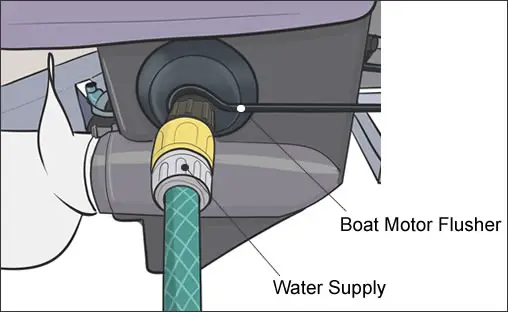
How To Start an Inboard Boat Engine Out Of Water
Starting an inboard boat engine out of the water can be dangerous for the engine if you are not doing it correctly. The proper tool to use for an inboard engine is called a Circular Cup Muff Plunger with Hose Fitting, also known as a “fake-a-lake” for your boat.
This tool is designed to look like a toilet plunger, and the way that it works is quite simple. It has an outlet attachment so you can connect an ordinary garden hose to it. The plunger will then cover the water intake hole on the bottom of the boat. When the water supply is turned on, it’ll begin to fill up the bowl of the plunger with water that will allow you to run the engine on land.
You can buy the muff plunger on Amazon for about $25. Click here for the current price.
How to set up the Circular Cup Muff Plunger With Hose Fitting
- Attach the garden hose to the muff plunger. Ensure that the hose is secure and tight.
- Turn on the garden hose all the way to confirm that there is a solid flow of water, then turn it off for now.
- While your boat is resting on a trailer, go underneath and locate the water intake hole.
- Take the muff plunger and put it up to the water intake opening so that the plunger part is completely covering the hole. Wedge the muff plunger securely into place by making sure that the leg is firmly against the ground. Adjust the height of the leg as you need to so that it’s nice and tight.
- Turn on the water supply all the way. You should see water pouring down from the muff plunger now. Ensure that the plunger is still nice and tight and that it is still completely covering the intake hole.
- Now it is safe to start your inboard engine. While the engine is running, you should keep an eye on the muff plunger to make sure that it hasn’t fallen off, and keep an eye on the temperature gauge. If the temperature begins to rise to 200 Fahrenheit, you should shut off the engine right away before it overheats.
- When you are finished, turn the engine off first, and then the water supply. Remove the muff plunger and disconnect the garden hose from the attachment.
Keep the RMP down and below 1,500 while the engine is idling.
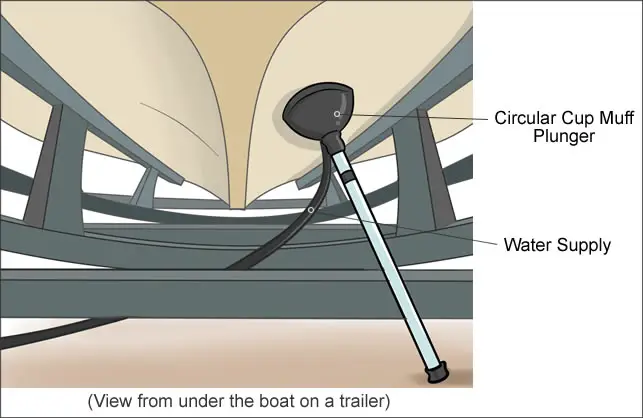
Putting Boat in Gear Out Of Water
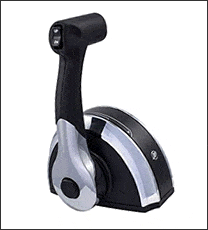
Some people might be wondering if they can put their boat in gear while it is sitting out of the water, and the short answer is yes, however before you do there are some things you need to know and do first.
Before you start the engine, take your garden hose and completely water down the strut bushings on the prop shaft from both sides. Doing this is important if your boat hasn’t been used in a while. After some time out of the water, the strut bushing will be tough to turn, and it will let out a screech once you’re in gear if it’s not lubricated.
Next, before you even start your engine, you need to make sure that there is a water hose attached to the water intake using a solid stream of water. If you have an inboard engine, you will need a Circular Cup Muff Plunger with Hose Fitting, and if you have an outboard engine, you’ll use a Moeller Flushrite Boat Motor Flusher. Do not try starting your engine without one of these hooked up.
Once you have the water supply hooked up and water is flowing strongly through the hose, you can now start your engine. Keep an eye on the temperature gauge and if it rises past 200 Fahrenheit shut it off right away.
Before you put it in the gear you need to make sure that nobody is nearby, there is nothing close to the propeller, and your pets are nowhere in sight. Once the coast is clear, you can put the engine in gear, but you only want to run it for a few seconds and never higher than idle speed.
